#Anton Goering
Text

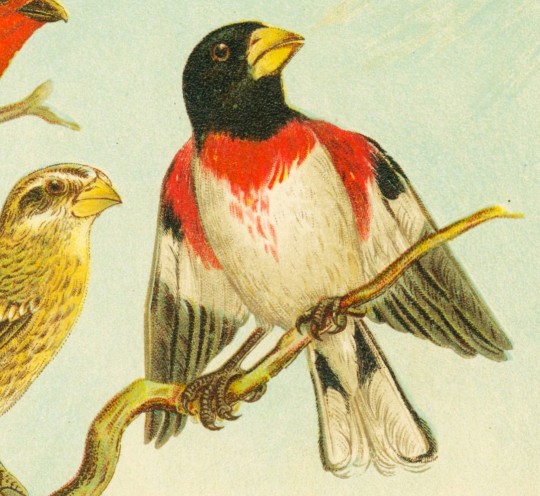

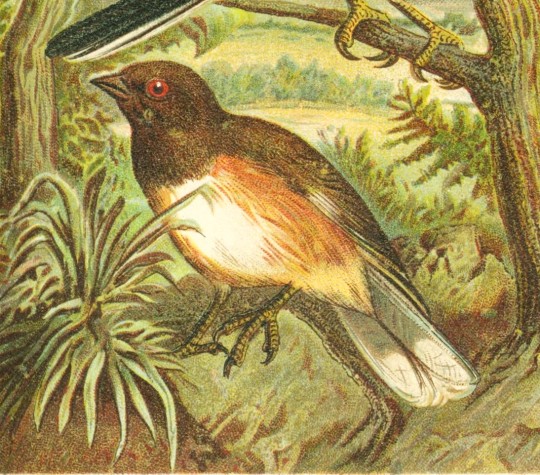


A Red-Flourish Feathursday
Today we present a chromolithograph of a male Scarlet Tanager (Piranga olivacea), a male and female Rose-breasted Grosbeak (Pheucticus ludovicianus), and a male and female Eastern Towhee (Pipilo erythrophthalmus) from a painting by German naturalist and artist Anton Goering (1836-1905), reproduced in our 2-volume set of Our Native Birds of Song and Beauty by the late-19th-century director of the Milwaukee Public Museum Henry Nehrling, and published in Milwaukee by George Brumder from 1893-1896.
The Tanager and Grosbeak are currently in the Cardinal family, while the Towhee is a sparrow. All three are fairly common in our neighborhood, but unfortunately, we rarely see them. However, we do hear them, or at least we think we hear them, since the song of the Tanager and Grosbeak are similar, and even worse, they both sound, to our ears, somewhat similar to the very common American Robin, which is an unrelated thrush:
Scarlet Tanager song
Rese-breasted Grosbeak song
American Robin song
Fortunately, the Towhee has a very distinctive call that we find easily recognizable:
Eastern Towhee song
Because German was prominently spoken in Milwaukee through the middle of the 20th century, these birds are also identified in Nehrling's book by their common German names:
Scarlet Tanager = Scharlachtangara
Rose-breasted Grosbeak = Rosenbrüstiger Kernbeisser
Eastern Towhee = Erdfink
View more posts from Nehrling’s Our Native Birds.
View more Feathursday posts.
#Feathursday#Scarlet Tanager#Rose-breasted Grosbeak#Eastern Towhee#Anton Goering#bird art#animal art#Henry Nehrling#George Brumder#Our Native Birds of Song and Beauty#chromolithographs#Yay chromoliths!#birds#birbs!
28 notes
·
View notes
Photo
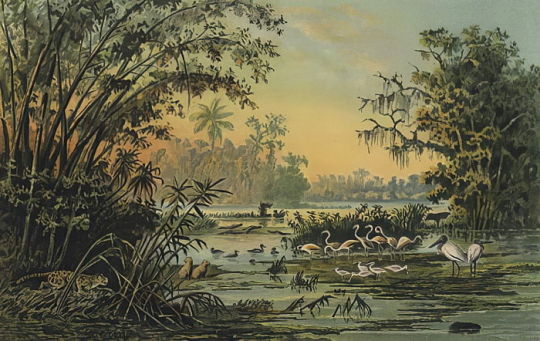
Wildlife in der Mitte Orinoco, Venezuela von Christian Anton Goering, Farblithographie
#Christian Anton Goering#landschaft#landschaftsmalerei#kunst#gemälde#meisterwerk#kunstdruck#museum#galerie#kunstwerk#alte meister#wildlife#venezuela#litography#birds#water birds
8 notes
·
View notes
Text

[ PROFiLES.02 ] く jobless ppl ₊☆



PARK WONBIN : a guitar player who works at his family's music store. wonbin, although he's very talented, has trouble getting gigs. luckily, a certain girl *wink wink* knows the right people.
LEE CHANYOUNG (ANTON) : plays cello in the seoul youth orchestra. one of wonbin's best friends. he likes to joke that he and wonbin are brothers because they constantly hang out.


KIM JIWON (LIZ) : jiwon is wonbin's very distant cousin who also likes to sing. she doesn't post her singing, though, because she's very shy.
SEOK WOOHYUN (MATTHEW) : matthew is an avid gym-goer. matthew met wonbin at the gym and later found out that he likes to sing too. he has a crush on this girl who goes to the same gym as him.

prev | masterlist | next
★. . description 𓂃 y/n plays the violin in a prestigious youth orchestra. wonbin is a struggling artist who works for his family's music store. when y/n's bow snaps during a rigorous day of practice, she searches high and low for her favorite brand but cannot find it anywhere. she settles for the local music shop and, low and behold, they sell it. wonbin needs a girlfriend and when y/n unintentionally interrupts his argument with his parents, he takes the opportunity.
★. . taglist 𓂃 @istphanie @tiziamattaga @sungbbinieworld @eun-luv @koeuh @hanizms | open! (send an ask or reply to this post to be added)

© 2024 HITTOKI. All Rights Reserved. Please do not copy or steal anything I post!
#── ♡ » hittoki#── ♡ » riize#── ♡ » dancing with you#riize#riize x reader#riize wonbin#park wonbin#wonbin#wonbin fluff#wonbin fanfic#park wonbin fanfic#wonbin x reader#riize smau#riize imagines#riize scenarios#riize fanfic#riize fluff
69 notes
·
View notes
Text

One Night in Cordonia
Chapter 7 : Almost back to normal
Series: One Night in Cordonia, a @choicesprompts Round Robin Event.
Fandom: TRR so far, but others could be added in
Pairings: Various
Word count : ~ Rating: Mature
Warnings: talks about sex, innuendos, language
Prompt: Fantasy @choicesjunechallenge or @liaromancewriter.
A/N: This has been a whirlwind, and Loved every minute of it.Thanks for including me. My sincere thanks to @angelasscribbles and @lizzybeth1986 for being the force behind the scenes.
A/N 2: I really am sorry that this is shorter than I wanted but, I had a family matter come up and I wanted to get something out. Xo
Next author: jerzwriter
Summary: It's Leo's social season. The day is Beaumont bash after the formal dinner is done and the royal couple has left. Anton sends his second in command Claudius to spread a fog "Death Smash" that would leave the guests paralyzed and he would attack. But the gas delivered was Shagging smog 2.0, by mistake, leading to a sexual frenzy amongst guests. Anton himself goes to check and falls prey to the gas. The only unaffected members are Max (immune), Leo (because he was in the gardens and Olivia (partially affected, trying to fight the effects)

After getting off the phone with his father, Leo went looking for Olivia and Max. Locating them he ordered them to gather up some of the Kings guards,” Liv, Max instruct the guards to gather everyone and lock them in all in separate rooms, I have the sex smog coming in an hour to reverse this fiasco but I need to get them separated so we don’t end up causing a huge scandal when they see who they are with.” “Okay we’re on it, come on Liv” Max called to Liv while on the phone to the second in command.
Standing in the main room in Ramsford, Connie could only shake his head at the chaos he just walked into. “ Hey pop’s” Leo called to him. “ I’m working on getting them into separate rooms so once the fog gets here and hooked up we can hopefully get the shit show under control” “ Okay son plus I need to talk to Maxwell these Bash’s have been out of control in the last few years, I don’t mind them their great for relieving stress but this has gone too far.” “ Yea I know,” Leo gives him a sad look knowing that this will more than likely depress Max, scaling down the Legendary Bash.
About an hour later, while Leo, Max, Connie and Liv were outside the Estate as the workers pumped in the Shag smog to try and reverse the effects it took on the party goers. Looking up into the windows of where they were locked in, Leo saw confusion in Liam’s eye’s as to what happened.
#choicesprompts#round robin#round robin 2023#trr au#collaboration#trr#the royal romance#choices fic writers creations#cfwc fics of the week
30 notes
·
View notes
Text
Hypnovember day 14: tail
I did not seach a pic for that day either, but it's the last one. I just had a clear idea in mind, and finding the exact furry art would have been complicated. @mathhypnostories
-
Nakura the jaguar had received an intriguing gift for his birthday by his shaman brother Numba. It was a little bell to tie at the end of his tail, which his brother had promised had hypnotic powers.
Nakura had someone in mind to use the bell on, but he was a bit uncertain how powerful the artifact was. So, he was planning on joining his best friend Raom on this week-end day so that they could try together. But then, he saw that handsome snow leopard in a green tank top that barely covered his entire chest and couldn’t hide a massive six pack, plus arms the size of a thick tree branch exiting the gym, and Nakura’s dick sprang to life in his pants.
Looking around to make sure that no one else was there to witness, Nakura took the bell out of his backpack and tied it with a purple ribbon. He then ran across the street to join the hot guy, the bell making a lot of noises as he sprinted. When he reached the snow leopard, the guy had stopped moving, and Nakura could observe him with rapt attention. The stranger was wearing black jeans so tight they were a sin, and had a bead bracelet around the left wrist.
Nakura was very flustered. “Wha-What is your name?” “Jukra, Master.” “Anton, Master.”
Shocked, Nakura turned and saw that a man had exited his car without the jaguar’s notice. It was a wolf with gray fur save for a few spots of white around his jaws, wearing leggings, baskets and a gray gym shirt that could barely contain the man’s pecs. The wolf was the male who had introduced himself as Anton.
Nakura was not expecting his brother’s gift to be THAT effective, certainly. But he was definitely enjoying it. Danfling the bell, he could see both the leopard and the wolf following the bell. “You are my slutty slaves who love to obey my every wish.”
“We are your slutty slaves who love to obey your every wish.” The pure unisson in the two rumbling voices was making Nakura’s tent inside his pants hurt. “Play with your pecs.” He was mostly interested with Anton, but Jukra immediately pinched his own nipples that had started to harden behind the tank top and moaned as he twisted them.
“Okay, no. Forget that last order!” Nakura smiled. “I know a place where we could have sex, you want this more than anything, right?” “Yes Master”. It was said as if the two gym-goers were about to climax. Nakura couldn’t wait to see those two banging on the table while his friend Raom, a swimmer, would be sucking him...
7 notes
·
View notes
Text
Delia's Gone: True Crime Murder Ballads Pt. 1

If you're a fan of old school folk, country, and jazz, chances are you've heard a song or two about Delia. But what you may not know is that these songs are inspired by real people. Songwriters through the years have taken varying degrees of creative license when telling the tale of Delia's fate, and the actual events surrounding her life and death are largely forgotten. She was a gambler in some versions, a prostitute in others. Today, the most well known version describes her as an evil woman whose luck ran out when she messed with the wrong guy.
In reality, Delia Green was a 14-year-old Black girl living in Savannah, Georgia in 1900 when she was shot and killed at a Christmas Eve party by 15-year-old Moses Houston. Intoxicated, Houston began publicly bragging to party goers about his sexual relationship with Green, using language to imply some sort of ownership over her. She denied it and rejected his claims, calling him a "son of a bitch" in the process. Ego bruised, he responded by shooting her in the groin. She succumbed to her injuries hours later, on Christmas day, and was buried in an unmarked grave in Savannah's Laurel Grove Cemetery. Houston was sentenced to life in prison, but only served 13 years before being granted parole.
Tragic circumstances like these often proved to be fertile grounds for songwriters, who rushed to use jaw-dropping breaking news stories to inspire fresh material. Though the original writers have been lost to time, Library of Congress field recordings suggest Delia Green was a popular lyrical subject from the time of her death until the end of the 1910s. While the tale of Green's murder fell out of favor for several decades, it returned with a vengeance by the middle of the century. Piedmont blues guitarist Blind Willie McTell recorded "Delia" and "Little Delia" in the 1940s, and Bahamas-based calypso musician Blake Alphonso Higgs recorded "Delia's Gone" in the 1950s. From there, the American folk music revival aroused a flurry of "Delia" covers, including from Pete Seeger, Bob Dylan, Josh White, and Burl Ives.
Johnny Cash released his own version in 1962, and another in 1994, the latter accompanied by a grotesquely glamorous Anton Corbijn-directed music video starring supermodel Kate Moss. Throughout the clip, Moss is posed dead-eyed beneath a noose and motionless at the bottom of a grave, dirt raining down on her. Cash, when not carrying Moss' lifeless body around, stands in a cemetery strumming his guitar, "DELIA" printed on the cross behind him. The song helped propel Cash's career comeback, with the LA Times proclaiming "Delia's Gone, But Man in Black's Back."

The recording itself is also particularly nasty. Adding verses that describe Delia as "cold and mean," Cash submits his actions as a blueprint for other men to follow: "So if your woman's devilish, you can let her run or you can bring her down and do her like Delia got done." While this rendition is particularly brutal considering the story behind the song, it's worth noting that this cold-hearted interpretation potentially matches the emotions of the moment more truthfully. During his confession, Houston reportedly exhibited zero remorse, saying he'd do it all over again if given the chance.
Not all versions are so cruel, however. Harry Belafonte released multiple stirring renditions, first in 1954 and again in 1967, lyrics rewritten to present the reason for Delia's mysterious absence as unknown. He also movingly covered the original in 1959, making him a particularly skilled interpreter of this story. And David Bromberg's 2016 re-recording is another standout among dozens of "Delia" performances.
In 2020, 120 years after her death, the non-profit Killer Blues Headstone Project raised the funds to finally deliver Green her own grave marker. It's a thoughtful tribute to the girl who has inspired countless musicians to pick up their guitar, but whose actual existence has been largely forgotten. So the next time you're singing along with "one more round, Delia's gone," remember the child whose death inspired those words. Rest in peace, Delia Green.
Follow me: Instagram / TikTok / Amazon
#delia green#delia's gone#delia#true crime#savannah#georgia#murder ballad#murder#blind willie mctell#little delia#pete seeger#bob dylan#johnny cash#burl ives#kate moss#harry belafonte#david bromberg#music
16 notes
·
View notes
Text
Summary: After Katherine says no to Viago’s offer to turn her, he drinks from a bar goer in an attempt to get smashed. Anton finds him ‘drunk’ in his room during the first get together between werewolves and vampires, Anton himself buzzed a bit himself from the party. A handsy Viago stumbles upon just the right things to say to Anton.
Rating: E
Tags: Top Anton, Bottom Viago, Plot What Plot, Anton POV, see link for more...
#what we do in the shadows#wwdits movie#wwdits viago#wwdits anton#anton/viago#wwdits fic#fanfic#fanfiction#my fic
16 notes
·
View notes
Text
'Those who have been following my stage reviews know I’m a big proponent of live theater. There’s no experience like it. Unlike a film, the magic is happening right in front of you, on a platform where no performance is ever the same from one show to another. Every high moment and mistake is there for the audience to see, to participate in, creating a different type of relationship. However, a downside is having to be present to see these shows, meaning they aren’t always easily accessible. So when you’re able to see a taped performance of a live show, such as Vanya, it’s the next best thing.
Based on Anton Chekhov’s classic Uncle Vanya, Vanya is currently playing on screens worldwide, thanks to National Theater Live, having recently played at the Duke of York’s Theatre in London. Vanya is adapted by Simon Stephens and Directed by Sam Yates, who also directed Magpie starring Daisy Ridley, which premiered at SXSW 2024.
Perhaps the most significant change is that Andrew Scott plays every part on stage, instead of an ensemble cast. As the only performer and co-creator, Scott carries this play on his shoulders.
[Warning: spoilers from Vanya are below!]
Vanya is a case study of humans and their relationships
I was unfamiliar with Chekhov’s Uncle Vanya, which is pretty much a retelling of another work, The Wood Demon. The original play explores the interconnectedness between four people and the emotions that become involved as they grow closer.
The major players in this version of the story are Alexander, an elderly filmmaker, his young second wife Helena, his daughter Sonia, the exhausted doctor Michael who has been called to the estate to provide some care, and of course Vanya. Andrew Scott plays a total of eight characters, each one with a distinct personality, mannerisms as well as patterns of speech.
Vanya brings these characters with larger-than-life personalities to the stage, allowing audience-goers a moment to sit down and experience life among them. The play is a case study of the human experience, which is perhaps one of the best parts of the entire show.
It’s not a super active play, with a gigantic story that moves from scene to scene. Instead, most of the play takes place in one room, with these characters conversing their way through difficult situations. Through this moment-by-moment exploration of these relationships, we learn so much about not just the characters, but also ourselves.
This feat is only amplified when you remember that every one of these characters is played by the same actor. One scene could see Scott jump between any of the eight characters, sometimes all of them, having to change his voice and his mannerisms very suddenly. It takes a high caliber of talent to be able to do, and Scott does it with such ease.
Switching between a gregarious character bouncing a tennis ball around the stage to a delicate, feminine character who fidgets with her necklace and speaks in a soft tone isn’t easy. I’ve heard stories about how difficult it can be to hold a single character when acting, let alone bouncing between extremes. It speaks to the talent that Andrew Scott has, as not many actors could do what he does live, night after night on stage.
A confusing narrative in this Anton Chekhov play
While the talent is impeccable here, there are quite a few downsides to this version of Chekhov’s play, the first being how much I struggled to follow along with the narrative. Part of this problem is that there doesn’t seem to be a specific narrative that connects Vanya from scene to scene; which is a result of the above-stated human case study that the play offers. Vanya is a narrow view into a specific point in these characters’ lives. The audience is getting a snapshot of each character in this exact moment, which doesn’t necessarily lend itself well to an overall narrative.
Instead, Vanya feels like it’s meandering through a story where not much happens. For some, this may be perfectly fine. However, I prefer a bit more story to my stage plays. Adding to the confusing nature of Vanya is the quick transitions that Andrew Scott has to manage throughout the show. At times, Scott switches between characters so quickly, that it becomes near impossible to discern who exactly he’s supposed to be. There’s one scene in particular where he’s sitting on a swing and switches between two characters, with barely enough time to switch the mannerisms that signify who exactly he’s playing.
As a result, I spent a good chunk of time unsure of what I was watching or what was going on throughout the play. I thought that it had something to do with it being an adapted Russian classic, which has never been one of my favorite genres, but it seems to be more reflective of the creative choices for this specific version of Uncle Vanya.
That being said, the work and effort put into this show by Andrew Scott is something spectacular to behold. There’s nothing quite like seeing someone who is not only great at acting, but loves what they are doing, and doing it well. Scott is in his element, with this being another successful role(s) among a long list of fantastic characters he’s brought to life.
Final thoughts on Andrew Scott’s Vanya
While I was a bit confused a few different times throughout Vanya, this version still feels like essential viewing for theater lovers. Now that I’ve seen it once, I think I would appreciate it more on additional viewings because I have a better understanding of what is going on and who exactly each one of these characters is.
The love and work that Andrew Scott put into this show are apparent from the first moment he arrives on stage. Vanya should be at the top of your viewing list.'
#Vanya#Andrew Scott#Anton Chekhov#Sam Yates#Simon Stephens#Uncle Vanya#Duke of York's Theatre#National Theatre Live
0 notes
Text
Ski-in, ski-out: Haute retreats across the Alps
The Alps’ summit-ready towns — Lech, St. Moritz and Chamonix, to name a few — make quite the convincing case to embrace the cold. Whether you’re a seasoned skier in pursuit of the world’s gnarliest peaks or a spa-goer chasing a treatment-heavy itinerary, here are my top destinations for exploring Europe’s high-altitude adventures.
POWDER PARADISE: MY TOP SKI-IN, SKI-OUT HOTELS
When clients ask what makes a ski trip spectacular, convenience is always at the top of my list. At a ski-in, ski-out hotel, you will step out of your suite and onto the slopes, eliminating the need for transportation to and from the mountain.
Better yet, waking up to the panoramic views and enjoying sunsets over the snow-capped peaks creates the most magical atmosphere for an alpine getaway. When you’re ready to book, let’s look into a few of my favorite destinations:
Cheval Blanc Courchevel in Courchevel, France
Four Seasons Hotel Megève in Megève, France
Grand Hotel des Bains Kempinski St Moritz in St. Moritz, Switzerland
The Chedi Andermatt in Andermatt, Switzerland
Request Details ⟶
SKI HARD, APRÈS SKI HARDER: HERE’S TO YOUR ALPINE GETAWAY
In the Alps, après ski celebrations aren’t just a practice; it’s a fully-fledged tradition. From sun-kissed brunches and boot-stomping concerts to firepits crackling with laughter and steam pouring from the spa, here are my top post-slope scenes.
Courchevel, France, is part of the extensive Three Valleys ski area and offers a luxurious après-ski experience, from upscale dining to exclusive clubs. Unwind in the many wellness centers with a massage, sauna session and other pampering treatments.
Where to stay: L’Apogee Courchevel, an Oetker Collection Hotel, or Aman Le Mélézin
Val d'Isère, France, is renowned for its heated outdoor terraces accompanied by stunning mountain views. Skiers and snowboarders gather on the terraces after a day on the slopes to bask in the sun. Enjoy warm drinks, live music and picturesque scenery.
Where to stay: Airelles Val d'Isère, Mademoiselle
Lech, Austria,is home to some of the most cozy and rustic lounges and chalets in the Alps. Plus, Lech-Oberlech-Zürs is linked to Warth-Schröcken-St. Anton via the Flexenbahn cableway, allowing you to conveniently explore après ski experiences across the Arlberg.
Where to stay: Post Lech Arlberg
Verbier, Switzerland, combines challenging slopes with a vibrant nightlife. This resort city has numerous bars and clubs to suit all tastes, and boasts world-renowned DJs and bands. If dancing speaks to you, check out Farinet Lounge and the legendary Farm Club.
Where to stay: The Lodge Verbier
Request Details ⟶
SPOTLIGHT ON:The Alps
Chamonix, France
MICHAEL SHANE STEPHENS
Curated Global Travel An affiliate of Protrave
[email protected]
310.691.7461 curatedglobaltravel.com
Copyright © 2024 Global Travel Collection
1633 Broadway, New York, NY 10019.
0 notes
Text
The Inaugural Manila Food and Wine Festival Kicks Off at The Westin Manila
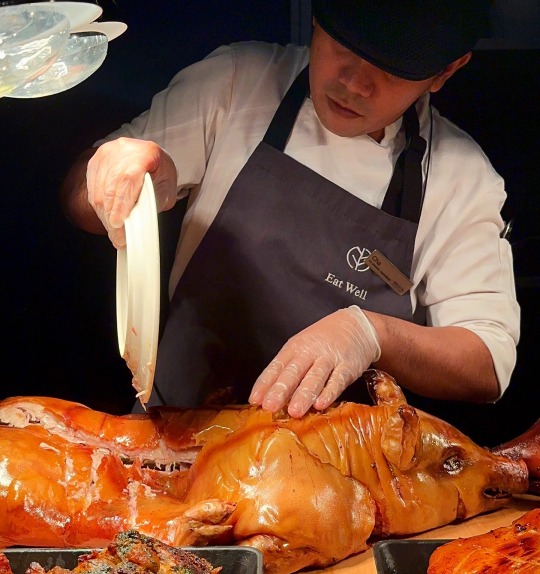
Inspired by the success of the Cebu Food and Wine Festival which held its third annual edition last June, Our Awesome Planet, Resto PH, and the Department of Tourism launched the inaugural Manila Food and Wine Festival last July 14, 2023 at the Grand Ballroom of The Westin Manila.

The Hungry Kat was invited to join this annual event that will draw food and wine enthusiasts from across the country to celebrate the finest that Metro Manila and the NCR region has to offer. The two-week event will run from July 14 to 27, 2023 across several restaurants and hotels in Manila showcasing the exciting works of talented celebrity chefs, restaurateurs, and culinary icons.

The inaugural Manila Food and Wine Festival is a gastronomic tourism celebration presented by the Department of Tourism that is also co-presented by Shangri-La Plaza, Discovery Primea, and Admiral Hotel Manila. Guests arrived at The Westin Manila Grand Ballroom for a night of exquisite food and wine selections from some of the country's best establishments.
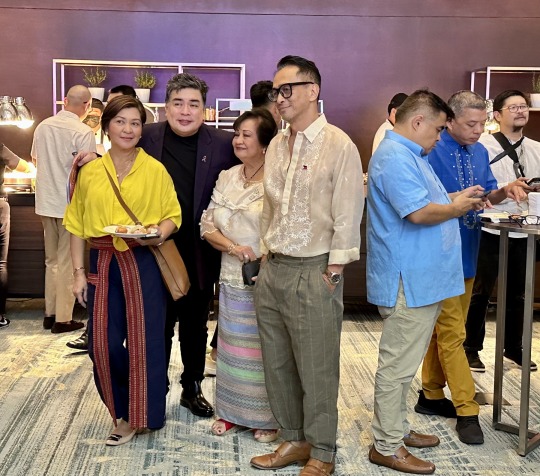
Joining the grand launch were special celebrity chefs, guest merchants and innovators from the food and beverage industry. Among those we spotted were Chef Sau Del Rosario, Chef Chelle Gonzales, Chef Kalen Chan, and more.

The host for the evening was none other than Manila Food and Wine Festival founder and organizer Spanky Enriquez who envisioned this annual event to promote food tourism in the country.
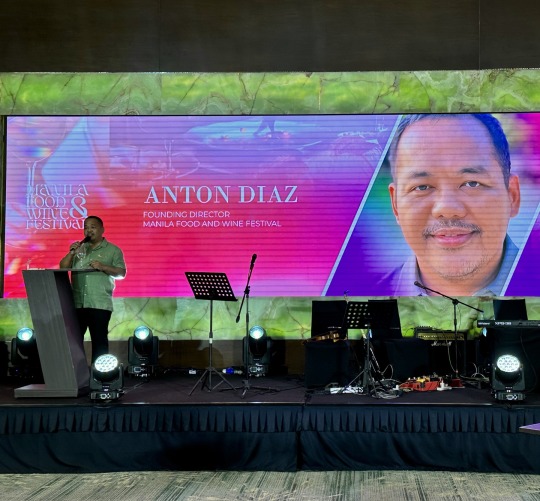
Our Awesome Planet founder Anton Diaz gave an opening speech to welcome all the guests to the Manila Food and Wine Festival which aims to establish Manila and The Philippines as the newest culinary capital in Asia. Their goal is to showcase the best of the Philippines' food and wine, hotels and restaurants, chefs and restaurateurs, and fuel the fire of innovation to elevate our Filipino food culture to the world. From July 14 to July 27, food lovers and wine enthusiasts will have the opportunity to immerse themselves in a gastronomic journey that showcases the country's vibrant food culture.

DOT OIC-Undersecretary for Tourism Development Verna Buensuceso said that the Manila Food and Wine Festival also aligns with the Department of Tourism's thrust to equalize opportunities across various areas of the country. She said that this project will really boost interest in food and gastronomy tourism. A plethora of exciting activities await festival-goers, including the festival bazaar at the Shangri-La Plaza Grand Atrium which ran last weekend, together with a series of chef collaborations in the best restaurants in Antipolo, Tagaytay, and Manila, a Makati pub crawl, a food stamping program, and the gala dinner finale.

One of these special events is the Gen Tsi, part of the Elements of Flavor series at Discovery Primea. Executive Chef Luis Chikiamco's passion for modern Asian fare stems from his extensive culinary experience from around the world. Together with Chef Sharwin Tee, who is known for his twists on Chinese-Filipino dishes, and Croissant Lady Donatella Chua, who creates playful pastry creations, they crafted a menu inspired by local dining scene favorites to highlight reminiscent flavors influenced by the Tsinoy culture. To elevate this gastronomic evening, Liquido Maestro Kalel Demetrio, an acclaimed mixologist of innovative concoctions, curated a selection of specialty cocktails to pair with the dishes. You can learn more about this exciting dinner happening on July 20, 2023 offered at P4,000++ per person at bit.ly/GenTsiAtFlame. You can also book your seats by calling 7955-8888.

The two week festival ends with a bang at the Manila Iconic at Admiral Hotel Manila - MGallery. The Manila Food and Wine Festival presents an exceptional dinner event with great food, wine, and entertainment at The Admiral Club, Admiral Hotel’s unique rooftop dining destination. Chef Sau Del Rosario, with special guest Chef Tatung Sarthou, will be preparing an indulgent 8-course Filipino menu, honoring the culinary icons of the country: Engracia “Aling Asiang” Reyes, Nora Daza, and Larry J. Cruz. The dishes will be highlighted by the dessert creations of Admiral Hotel Manila's own Executive Pastry Chef, Christian Monera. Manila Iconic will be held on July 27, 2023. You can book your seats now at P7,000 nett.

The grand launch of the Manila Food and Wine Festival continued with guests sampling the many food and beverage options on display at the Westin Manila Grand Ballroom.

Destileria Limtuaco brought out its cocktail menu that included their Manille Basil Smash, a combination of Empire London Dry Gin, Manille Liqueur de Calamansi, lemon juice, and basil syrup. Another popular cocktail was the Mango Rind Punch using Old Captain Rum and Paradise Mango Rum liqueur.

Luisita Rum also offered their specialty Luisita Oro straight, on the rocks, or as a unique cocktail that included coconut juice and nata de coco.


Other wines and beers were also available for guests to sample including Pilsner Urquell, Caymus Vineyard wines, and more.

The mooncake season is fast approaching so The Hungry Chef, who makes one of the country's best home-based mooncakes, gave samples for guests to enjoy.
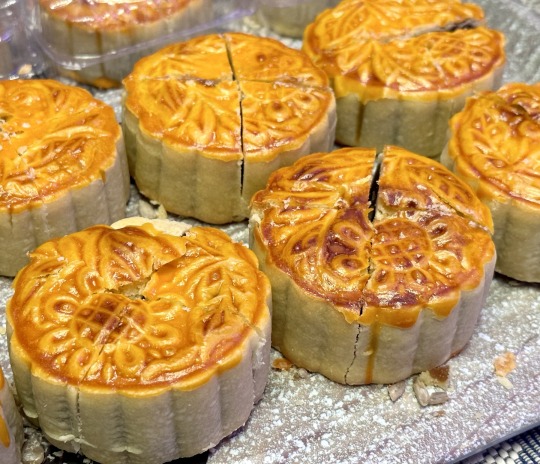

The Westin Manila also brought out its special dishes and everyone lined up to try these creations. The Banana Couture is a unique appetizer that deceptively looks like an ordinary banana but is actually not! It's a banana pudding with a coconut and white chocolate glaze shell that you have to see to believe.

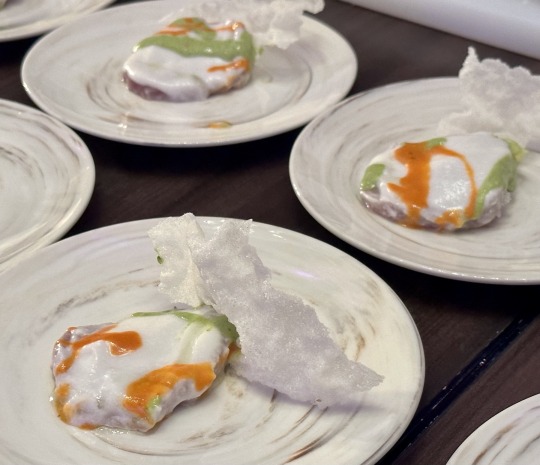
We were also shown The Art of Kinilaw which uses sustainable tuna, coconut and cane vinegar glaze, cilantro aioli, and chili pearls. This is a more flavorful and colorful version of the kinilaw we know.

Next is the Cavingero, a crispy lechon belly tacos with watermelon rind atchara and roasted garlic sauce. These bite-sized canapes really made us hungry for more.

The main courses were also impressive. The Chicken Tinola Paella Overload is a delightful deconstructed rendition of the classic Filipino favorite with crispy chicken skin and chili garlic crumbs on top of paella rice. This is a complete meal on its own!
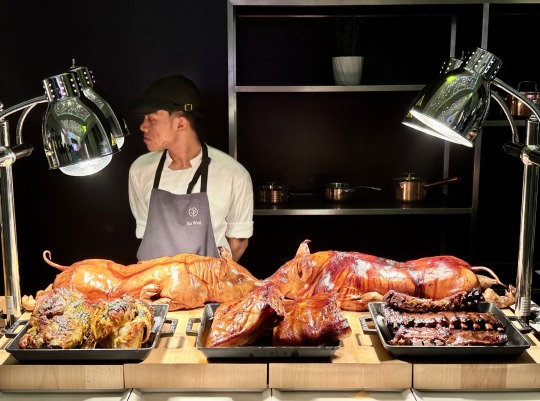
The highlight of the night was the carving station featuring Kurobuta Lechon and other meaty dishes from Esguerra Kurobuta. Aside from the very crispy lechon skin and tender lechon meat using Bershire black pigs, they also had roast pork, roast chicken, and delicious baby back ribs.

For desserts, Karabella Dairy and Destileria Limtuaco had a collaboration that showcased their spiked gelatos like the Intramuros Liqueur de Cacao Gelato, Manille Liqueur de Calamnsi Gelato, and the Paradise Mango Rum Liqueur Gelato.

Another surprising item that evening was the Pork Sisig Donut Bites from Westin Manila. These look like ordinary glazed donuts on the outside but are actually filled with savory sisig on the inside. It also comes with calamansi and chicharon crumble, so I'm not really sure if this counts as a dessert or an appetizer.

Macarons Macarons offered its premium French macaron variants like the Queso de Bola Macarons, Macapuno Macarons, Milo French Macarons, and even Chili Macarons.

There's always room for more ice cream so the Philippine Fruit Dessert Trio from Sebastian's Ice Cream was also a wonderful treat. The first item is a Lanzones Sorbet made with duco lanzones and garnished with fresh mint. At the back is the Dalandan Ice Cream made with fresh dalandan and garnished with candied dalandan peel. Lastly, the one in the middle is the Avocado Tres Leches using avocado ice cream made with avocado layered on tres leches cake soaked in condensed evaporated milk. Congratulations to the entire team of the Manila Food and Wine Festival for a successful launch. Visit their Facebook page to know more about the other exciting events in store for the next two weeks.

Manila Food and Wine Festival 2023
(0917) 568-3627
www.facebook.com/manilafoodandwine
1 note
·
View note
Quote
Schoenberg – String Quartet no.2 “in f# minor”
I have to admit it’s taken me a long time to appreciate the Second Viennese School. I always defended them from haters, because I respect their contribution to music and their importance in music history, but at the same time I felt like I never “got” their music. The more I listened to Schoenberg’s earlier pieces, the “accessible” Romantic ones, I realized that his writing isn’t any more “easier” in conventional tonality either. Instead of thinking of Schoenberg as a revolutionary Modernist whose music is somehow “above” the general public, think of him as an extension of Brahms, pushing harmonies out of “order”, not to be cold and mathematic, but to be deeply passionate. The second string quartet is a great example of breaking convention for musical expression. It was written during a very painful moment in Schoenberg’s life, when he found out his wife had been having an affair with their friend and neighbor, the artist Richard Gerstl. She left Schoenberg with their kids to stay with Gerstl, but fellow composer and friend Anton Webern convinced her to come back to Schoenberg. The heartache drove Gerstl to suicide. So much melodrama and pain at once! Betrayal from his wife, from his friend, and then the suicide of that same friend. You can hear this pain in the music, this quartet dedicated to his wife. The opening movement starts in f# minor, but immediately it modulates into distant keys. The main melody pops up again and again, our only life preserver in a relentless ocean of flowing harmonies. Even though the ambiguity, the movement ends in f# minor. The second movement starts out implying d minor, but again, it immediately flies all over the place, like stormy winds, knife stabs. The third movement is so far the least conventional, where tonality is hinted at, a soprano joins the quartet in a song, a poem by Stefan George, a poem about pain, longing for peace and love. The final movement has no key signature, and is the first concrete example of complete tonal abandonment in western music. The second song, another poem by George, opens with “I feel the air from another planet”. This poem and movement is almost a celebration of the ecstasy of the sublime, like a spiritual transcendence that can barely be explained. Reception was poor. The audience was alright with the first movement, but the rest of the movements were off putting. Apparently, at a pause in the music, someone sneezed and that caused an uproar of laughter that couldn’t be contained. When the soprano came on stage, people hissed, telling her to shut up and get off the stage, that they’ve had enough. No one clapped. This music was too bizarre. And I imagine, for a turn of the century Austrian music goer, scary. This was music of another planet, a new world, the world of the 20th century. I understand the fear.
Movements:
1. Mäßig
2. Sehr rasch
3. “Litanei”, langsam
4. “Entrückung”, sehr langsam
mikrokosmos: Schoenberg – String Quartet no.2 “in f# minor” I have to admit it’s taken me a long time to appreciate the Second Viennese School. I always defended them from haters, because I respect their contribution to music and their importance in music history, but at the same time I felt like I never “got” their music.…
0 notes
Photo

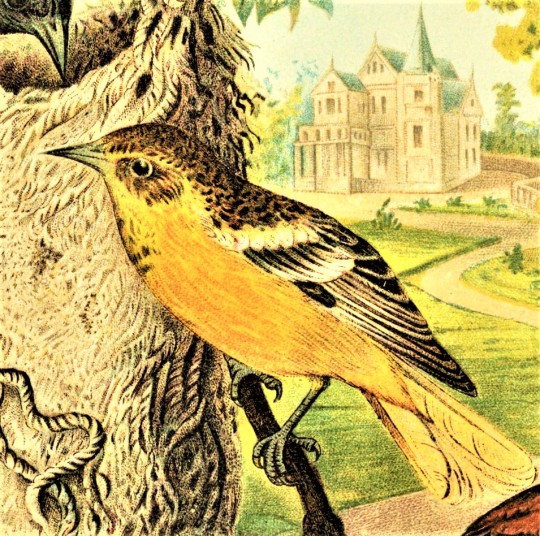

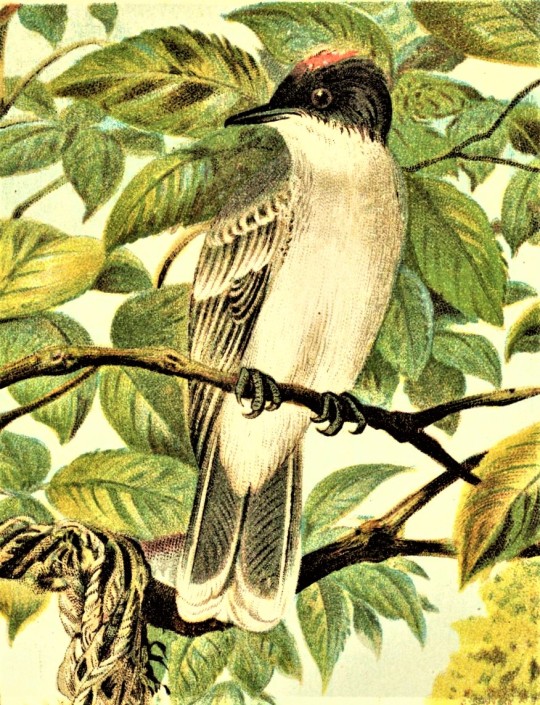
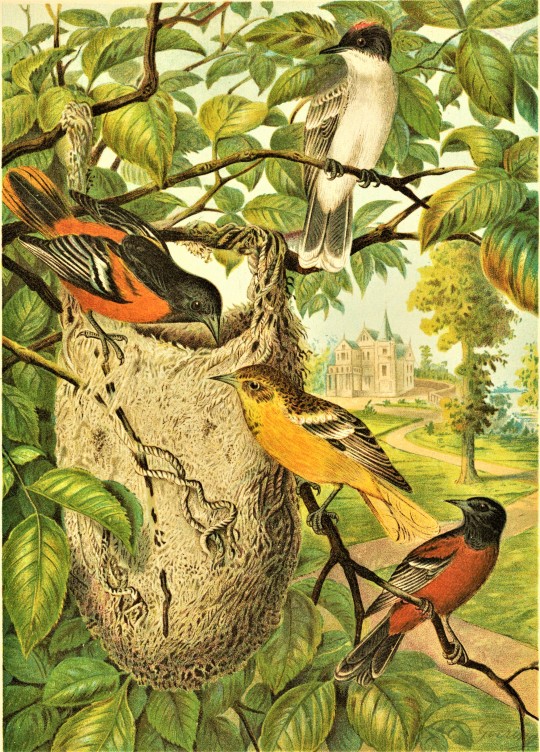
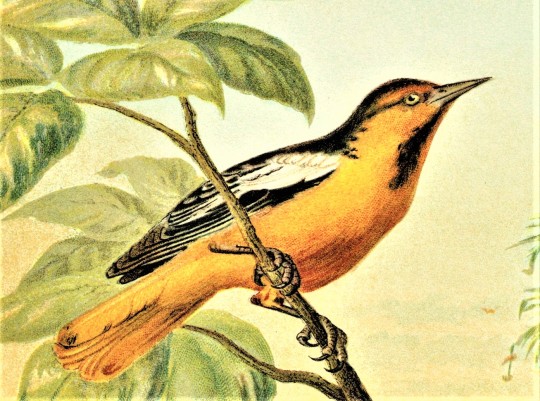


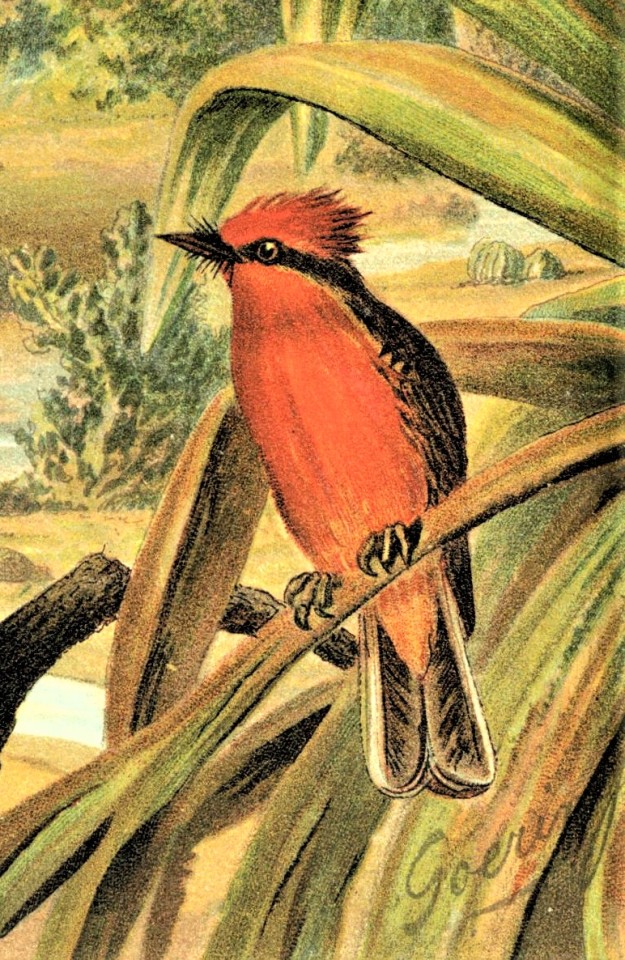
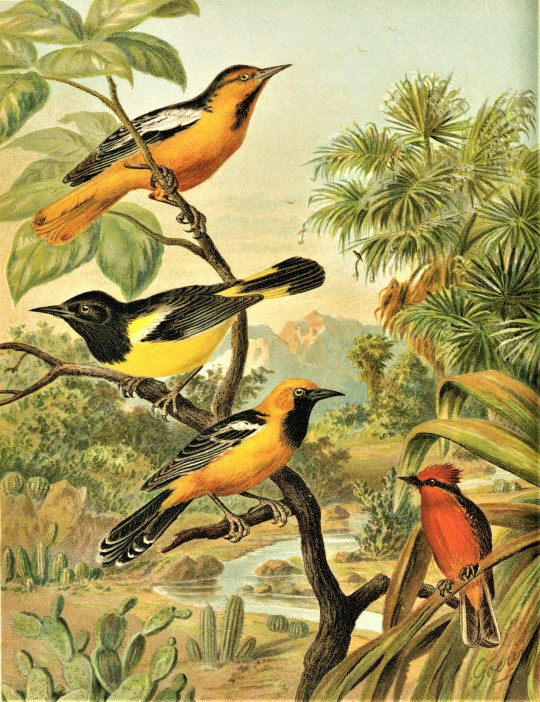
Feathursday Orioles!
Here are a few chromolithographic Feathursday Orioles, along with a Kingbird and a Flycatcher, from our 2-volume set of Our Native Birds of Song and Beauty, by the late-19th-century director of the Milwaukee Public Museum Henry Nehrling, and published in Milwaukee by George Brumder from 1893-1896. The lithographs are based on original water color paintings by the German naturalist painter Anton Goering. The individual birds from top to bottom are:
Baltimore Oriole (Icterus galbula), male.
Baltimore Oriole (Icterus galbula), female.
Orchard Oriole (Icterus spurius).
Eastern Kingbird (Tyrannus tyrannus).
Bullock's Oriole (Icterus bullockii).
Scott's Oriole (Icterus parisorum).
Hooded Oriole (Icterus cucullatus).
Scarlet Flycatcher (Pyrocephalus rubinus).
View more posts from Nehrling’s Our Native Birds.
View more Feathursday posts.
#Feathursday#orioles#kingbirds#flycatchers#henry nehrling#Anton Goering#George Brumder#Our Native Birds of Song and Beauty#Baltimore Oriole#Orchard Oriole#Bullock's Oriole#Scott's Oriole#hooded oriole#Eastern Kingbird#Scarlet Flycatcher#bird paintings#chromolithographs#Yay chromoliths!#wading birds#birbs!
66 notes
·
View notes
Quote
Schoenberg – String Quartet no.2 “in f# minor”
I have to admit it’s taken me a long time to appreciate the Second Viennese School. I always defended them from haters, because I respect their contribution to music and their importance in music history, but at the same time I felt like I never “got” their music. The more I listened to Schoenberg’s earlier pieces, the “accessible” Romantic ones, I realized that his writing isn’t any more “easier” in conventional tonality either. Instead of thinking of Schoenberg as a revolutionary Modernist whose music is somehow “above” the general public, think of him as an extension of Brahms, pushing harmonies out of “order”, not to be cold and mathematic, but to be deeply passionate. The second string quartet is a great example of breaking convention for musical expression. It was written during a very painful moment in Schoenberg’s life, when he found out his wife had been having an affair with their friend and neighbor, the artist Richard Gerstl. She left Schoenberg with their kids to stay with Gerstl, but fellow composer and friend Anton Webern convinced her to come back to Schoenberg. The heartache drove Gerstl to suicide. So much melodrama and pain at once! Betrayal from his wife, from his friend, and then the suicide of that same friend. You can hear this pain in the music, this quartet dedicated to his wife. The opening movement starts in f# minor, but immediately it modulates into distant keys. The main melody pops up again and again, our only life preserver in a relentless ocean of flowing harmonies. Even though the ambiguity, the movement ends in f# minor. The second movement starts out implying d minor, but again, it immediately flies all over the place, like stormy winds, knife stabs. The third movement is so far the least conventional, where tonality is hinted at, a soprano joins the quartet in a song, a poem by Stefan George, a poem about pain, longing for peace and love. The final movement has no key signature, and is the first concrete example of complete tonal abandonment in western music. The second song, another poem by George, opens with “I feel the air from another planet”. This poem and movement is almost a celebration of the ecstasy of the sublime, like a spiritual transcendence that can barely be explained. Reception was poor. The audience was alright with the first movement, but the rest of the movements were off putting. Apparently, at a pause in the music, someone sneezed and that caused an uproar of laughter that couldn’t be contained. When the soprano came on stage, people hissed, telling her to shut up and get off the stage, that they’ve had enough. No one clapped. This music was too bizarre. And I imagine, for a turn of the century Austrian music goer, scary. This was music of another planet, a new world, the world of the 20th century. I understand the fear.
Movements:
1. Mäßig
2. Sehr rasch
3. “Litanei”, langsam
4. “Entrückung”, sehr langsam
mikrokosmos: Schoenberg – String Quartet no.2 “in f# minor” I have to admit it’s taken me a long time to appreciate the Second Viennese School. I always defended them from haters, because I respect their contribution to music and their importance in music history, but at the same time I felt like I never “got” their music.…
0 notes
Quote
Schoenberg – String Quartet no.2 “in f# minor”
I have to admit it’s taken me a long time to appreciate the Second Viennese School. I always defended them from haters, because I respect their contribution to music and their importance in music history, but at the same time I felt like I never “got” their music. The more I listened to Schoenberg’s earlier pieces, the “accessible” Romantic ones, I realized that his writing isn’t any more “easier” in conventional tonality either. Instead of thinking of Schoenberg as a revolutionary Modernist whose music is somehow “above” the general public, think of him as an extension of Brahms, pushing harmonies out of “order”, not to be cold and mathematic, but to be deeply passionate. The second string quartet is a great example of breaking convention for musical expression. It was written during a very painful moment in Schoenberg’s life, when he found out his wife had been having an affair with their friend and neighbor, the artist Richard Gerstl. She left Schoenberg with their kids to stay with Gerstl, but fellow composer and friend Anton Webern convinced her to come back to Schoenberg. The heartache drove Gerstl to suicide. So much melodrama and pain at once! Betrayal from his wife, from his friend, and then the suicide of that same friend. You can hear this pain in the music, this quartet dedicated to his wife. The opening movement starts in f# minor, but immediately it modulates into distant keys. The main melody pops up again and again, our only life preserver in a relentless ocean of flowing harmonies. Even though the ambiguity, the movement ends in f# minor. The second movement starts out implying d minor, but again, it immediately flies all over the place, like stormy winds, knife stabs. The third movement is so far the least conventional, where tonality is hinted at, a soprano joins the quartet in a song, a poem by Stefan George, a poem about pain, longing for peace and love. The final movement has no key signature, and is the first concrete example of complete tonal abandonment in western music. The second song, another poem by George, opens with “I feel the air from another planet”. This poem and movement is almost a celebration of the ecstasy of the sublime, like a spiritual transcendence that can barely be explained. Reception was poor. The audience was alright with the first movement, but the rest of the movements were off putting. Apparently, at a pause in the music, someone sneezed and that caused an uproar of laughter that couldn’t be contained. When the soprano came on stage, people hissed, telling her to shut up and get off the stage, that they’ve had enough. No one clapped. This music was too bizarre. And I imagine, for a turn of the century Austrian music goer, scary. This was music of another planet, a new world, the world of the 20th century. I understand the fear.
Movements:
1. Mäßig
2. Sehr rasch
3. “Litanei”, langsam
4. “Entrückung”, sehr langsam
mikrokosmos: Schoenberg – String Quartet no.2 “in f# minor” I have to admit it’s taken me a long time to appreciate the Second Viennese School. I always defended them from haters, because I respect their contribution to music and their importance in music history, but at the same time I felt like I never “got” their music.…
0 notes
Quote
Schoenberg – String Quartet no.2 “in f# minor”
I have to admit it’s taken me a long time to appreciate the Second Viennese School. I always defended them from haters, because I respect their contribution to music and their importance in music history, but at the same time I felt like I never “got” their music. The more I listened to Schoenberg’s earlier pieces, the “accessible” Romantic ones, I realized that his writing isn’t any more “easier” in conventional tonality either. Instead of thinking of Schoenberg as a revolutionary Modernist whose music is somehow “above” the general public, think of him as an extension of Brahms, pushing harmonies out of “order”, not to be cold and mathematic, but to be deeply passionate. The second string quartet is a great example of breaking convention for musical expression. It was written during a very painful moment in Schoenberg’s life, when he found out his wife had been having an affair with their friend and neighbor, the artist Richard Gerstl. She left Schoenberg with their kids to stay with Gerstl, but fellow composer and friend Anton Webern convinced her to come back to Schoenberg. The heartache drove Gerstl to suicide. So much melodrama and pain at once! Betrayal from his wife, from his friend, and then the suicide of that same friend. You can hear this pain in the music, this quartet dedicated to his wife. The opening movement starts in f# minor, but immediately it modulates into distant keys. The main melody pops up again and again, our only life preserver in a relentless ocean of flowing harmonies. Even though the ambiguity, the movement ends in f# minor. The second movement starts out implying d minor, but again, it immediately flies all over the place, like stormy winds, knife stabs. The third movement is so far the least conventional, where tonality is hinted at, a soprano joins the quartet in a song, a poem by Stefan George, a poem about pain, longing for peace and love. The final movement has no key signature, and is the first concrete example of complete tonal abandonment in western music. The second song, another poem by George, opens with “I feel the air from another planet”. This poem and movement is almost a celebration of the ecstasy of the sublime, like a spiritual transcendence that can barely be explained. Reception was poor. The audience was alright with the first movement, but the rest of the movements were off putting. Apparently, at a pause in the music, someone sneezed and that caused an uproar of laughter that couldn’t be contained. When the soprano came on stage, people hissed, telling her to shut up and get off the stage, that they’ve had enough. No one clapped. This music was too bizarre. And I imagine, for a turn of the century Austrian music goer, scary. This was music of another planet, a new world, the world of the 20th century. I understand the fear.
Movements:
1. Mäßig
2. Sehr rasch
3. “Litanei”, langsam
4. “Entrückung”, sehr langsam
mikrokosmos: Schoenberg – String Quartet no.2 “in f# minor” I have to admit it’s taken me a long time to appreciate the Second Viennese School. I always defended them from haters, because I respect their contribution to music and their importance in music history, but at the same time I felt like I never “got” their music.…
0 notes
Photo
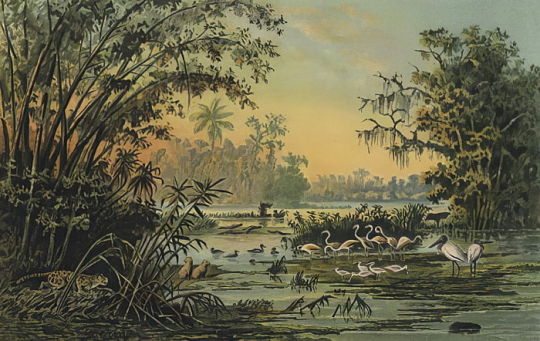
Wildlife in der Mitte Orinoco, Venezuela
von Christian Anton Goering
Farblithographie
Private Collection
#Christian Anton Goering#landschaft#landschaftsmalerei#kunst#gemälde#meisterwerk#kunstdruck#museum#galerie#kunstwerk#alte meister
0 notes